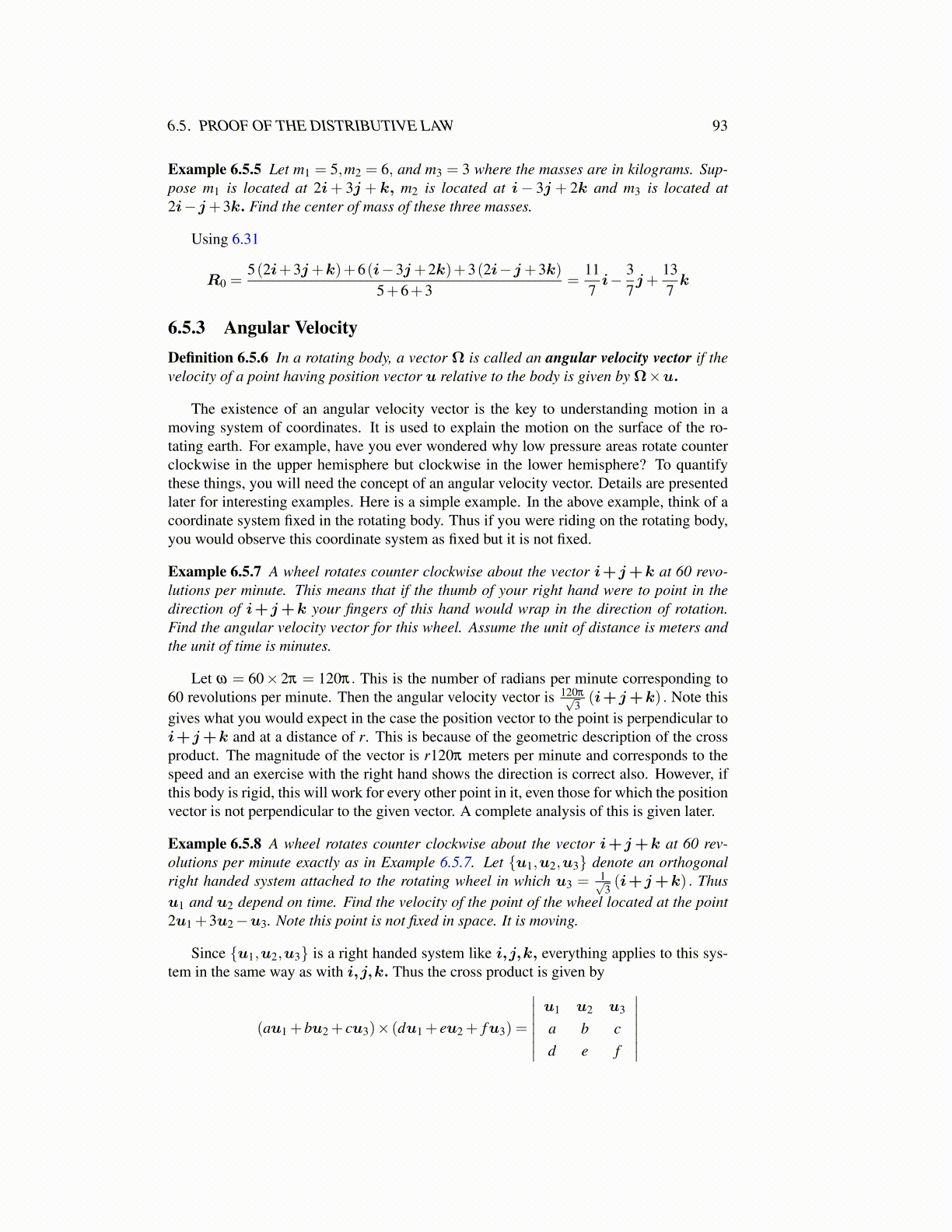
6.5. PROOF OF THE DISTRIBUTIVE LAW 93
Example 6.5.5 Let m1 = 5,m2 = 6, and m3 = 3 where the masses are in kilograms. Sup-pose m1 is located at 2i+ 3j + k, m2 is located at i− 3j + 2k and m3 is located at2i−j+3k. Find the center of mass of these three masses.
Using 6.31
R0 =5(2i+3j+k)+6(i−3j+2k)+3(2i−j+3k)
5+6+3=
117i− 3
7j+
137k
6.5.3 Angular VelocityDefinition 6.5.6 In a rotating body, a vector Ω is called an angular velocity vector if thevelocity of a point having position vector u relative to the body is given by Ω×u.
The existence of an angular velocity vector is the key to understanding motion in amoving system of coordinates. It is used to explain the motion on the surface of the ro-tating earth. For example, have you ever wondered why low pressure areas rotate counterclockwise in the upper hemisphere but clockwise in the lower hemisphere? To quantifythese things, you will need the concept of an angular velocity vector. Details are presentedlater for interesting examples. Here is a simple example. In the above example, think of acoordinate system fixed in the rotating body. Thus if you were riding on the rotating body,you would observe this coordinate system as fixed but it is not fixed.
Example 6.5.7 A wheel rotates counter clockwise about the vector i+j+k at 60 revo-lutions per minute. This means that if the thumb of your right hand were to point in thedirection of i+j+k your fingers of this hand would wrap in the direction of rotation.Find the angular velocity vector for this wheel. Assume the unit of distance is meters andthe unit of time is minutes.
Let ω = 60× 2π = 120π. This is the number of radians per minute corresponding to60 revolutions per minute. Then the angular velocity vector is 120π√
3(i+j+k) . Note this
gives what you would expect in the case the position vector to the point is perpendicular toi+j+k and at a distance of r. This is because of the geometric description of the crossproduct. The magnitude of the vector is r120π meters per minute and corresponds to thespeed and an exercise with the right hand shows the direction is correct also. However, ifthis body is rigid, this will work for every other point in it, even those for which the positionvector is not perpendicular to the given vector. A complete analysis of this is given later.
Example 6.5.8 A wheel rotates counter clockwise about the vector i+j+k at 60 rev-olutions per minute exactly as in Example 6.5.7. Let {u1,u2,u3} denote an orthogonalright handed system attached to the rotating wheel in which u3 = 1√
3(i+j+k) . Thus
u1 and u2 depend on time. Find the velocity of the point of the wheel located at the point2u1 +3u2−u3. Note this point is not fixed in space. It is moving.
Since {u1,u2,u3} is a right handed system like i,j,k, everything applies to this sys-tem in the same way as with i,j,k. Thus the cross product is given by
(au1 +bu2 + cu3)× (du1 + eu2 + fu3) =
∣∣∣∣∣∣∣u1 u2 u3
a b cd e f
∣∣∣∣∣∣∣